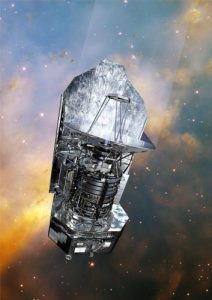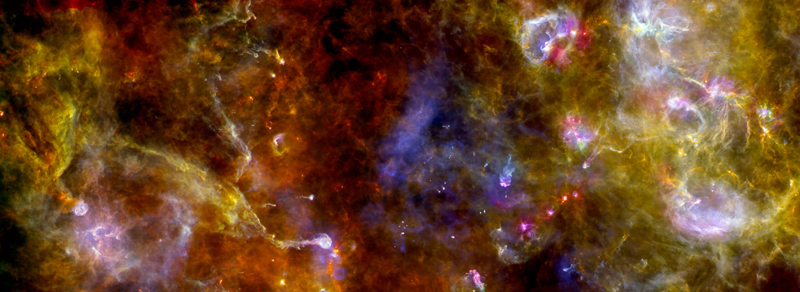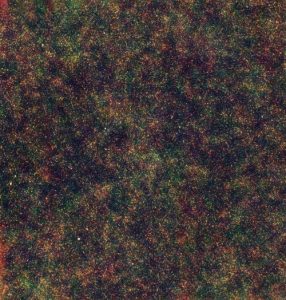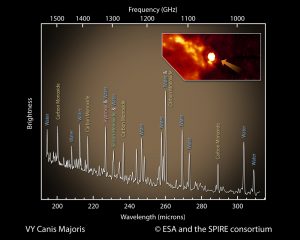
The Herschel Space Observatory has exhausted its supply of liquid helium coolant, after three and a half years of scientific observations. Using Herschel data, astronomers have already made ground-breaking discoveries about the formation and evolution of stars, galaxies and planets. But this has only scratched the surface, and there is far more still to come from the immense archive.
A flagship mission for the UK Space Agency, Herschel carried over 2000 litres of liquid helium when launched by ESA in May 2009, allowing its instruments to be cooled to a few degrees above absolute zero (-273 C). Two of the instruments also contained internal coolers to get their detectors even colder – only a third of a degree above absolute zero. Over the course of the mission the helium slowly evaporated, with the tank having now finally running dry. Herschel’s 3.5 metre diameter mirror and extremely sensitive scientific instruments made it the most powerful infrared observatory ever launched. Because none of the instruments can work without helium-cooling, Herschel’s operational life is now over. The SPIRE (Spectral and Photometric Imaging Receiver) instrument, responsible for keeping all the spacecraft’s instrumentation cool, making images of the sky simultaneously in three submillimetre ‘colours’ and measuring the spectral features of atoms and molecules, was led by the UK. The spacecraft itself will now be placed in a parking orbit around the Sun, but the analysis and evaluation of the data will continue for years to come.
“Herschel’s observations have revealed the cosmos in unprecedented detail at these wavelengths,” comments Göran Pilbratt, Herschel Project Scientist at ESA. “We have very exciting results from the observatory’s first few years and we are looking forward to many more exciting discoveries,” he adds.
By observing far-infrared and sub-millimetre light, Herschel’s three instruments have studied the coldest parts of the Universe. Rather than observing stars, Herschel has been observing the gas and dust grains from which stars and planets form, and which also play an important role in the evolution of galaxies. This interstellar material is generally very cold, sometimes at temperatures below -260 C, with some regions being warmed to higher temperatures by newly-formed stars.
In visible light this dust is dark and opaque, hiding from view the regions where stars are currently forming. But in the far-infrared light which Herschel could see, the dust emits its own glow, and allows astronomers to study the birthplaces of stars in great detail. By surveying huge regions of our galaxy, Herschel showed that a filamentary network of gas and dust is threaded through the interstellar medium.
“We did expect that there would be filaments in the interstellar medium, but Herschel finally gave us proof that they are omnipresent and that they are key to allowing star formation to occur,” explains Matt Griffin, of Cardiff University and the lead scientist of Herschel’s SPIRE instrument. “Herschel’s beautifully detailed images show how some clouds have developed filaments so dense that they are collapsing under their own gravity and starting to form stars, while other clouds exhibit a more chaotic tangle of more tenuous filaments and are not dense enough to form stars – at least, not yet,” he adds.

“Thanks to Herschel, we now have a much better understanding of how stars form and how they are affected by their environment”, says Derek Ward Thompson, of University of Central Lancashire. “The images are hugely detailed, and we’re going to be searching them for new objects for years to come”

Herschel has also observed the formation of stars in other galaxies, both near and far. This ranges from our nearest large neighbour, the Andromeda Galaxy, to galaxies billions of light years away. By staring at seemingly empty patches of sky, Herschel has seen hundreds of thousands of distant galaxies. These are seen at a range of distances, with the more distant galaxies seen as they were when the Universe was younger, allowing astronomers to study how galaxies have changed and evolved over the history of the cosmos.
“The distant galaxies we see with Herschel are showing us when and where stars were being formed between around 3 and 10 billion years ago,” explains Seb Oliver, of University of Sussex. “At this time galaxies were forming stars hundreds or thousands of times of faster than they are today, and so is hugely important to understanding the cosmic evolution of galaxies”.

Herschel’s instruments did not just produce pictures, but also carried spectrometers to allow astronomers to study the full range of wavelengths in great details. This allows the identification of specific atoms and molecules in interstellar space and in distant galaxies.
After performing 22,000 hours of scientific observations, Herschel’s archive of data is an invaluable resource for astronomers interested in a huge range of objects. “The six hundred scientific papers published so far are just the tip of the iceberg, and over the next few years there’ll be many more fascinating results coming out of the Herschel archive,” concluded Matt Griffin.
